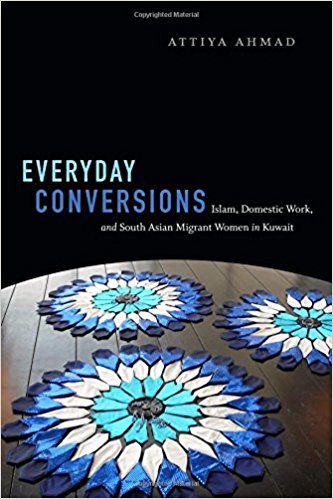The topic of religious conversion often serves as a proxy for various political preoccupations and as an entry point into larger questions of identity and belonging on both local and global scales. In her recent ethnography, Everyday Conversions: Islam, Domestic Work and South Asian Migrant Women in Kuwait, Attiya Ahmad steers clear of simplistic explanations of conversion to instead offer an intimate portrait of how this process is just one interwoven strand in the complex fabric of the daily lives of her interlocutors: South Asian women who have migrated to Kuwait as domestic workers.
These women’s conversions to Islam are interpreted by liberal secularists as being motivated by pragmatic considerations shaped by the women’s marginal positions within the households where they work and in Kuwaiti society more broadly. Islamic reformists, on the other hand, interpret them as evidence of the efficacy of their movements’ efforts to promote everyday piety and social reform. Ahmad’s approach, informed by transnational feminism, cultivates a holistic understanding that privileges her interlocutors’ understandings of their own lives and attends to the interrelated historical, social, political and economic forces that shape the everyday.
The structure of Everyday Conversions is elegant. Following an introduction which provides necessary background on the socioeconomic systems that shape the Kuwaiti households in which her interlocutors work (such as the kafala system and citizenship laws in Kuwait), Ahmad builds each of her chapters around recurring themes which emerged in her conversations with South Asian domestic worker women and which are crucial to understanding their experiences of conversion. These themes are temporariness, suspension, naram (Urdu/Hindi: softness, malleability), housetalk and fitra (Arabic: disposition, human nature). Each chapter begins with a description of an ethnographic moment in which the chapter’s theme became particularly salient.
Image Credit: Grand Mosque, Kuwait (Humoud Meshaal CC BY 2.0)
Chapter Three, for instance, opens by recounting a conversation between Ahmad and her interlocutors Hema and Ritu, Nepali women who had returned from Kuwait to their families of origin in Nepal. Hema and Ritu empathise with each other about the fact that they feel a social pressure to act as if they had never gone to the Gulf. They explain to Ahmad that, as women, they are expected to cultivate a quality of being naram, soft or malleable, in order to accommodate themselves to new social settings. Unlike men, who are expected to ‘show’ that they have been working abroad and are perceived as less adaptable to their environments, women are expected to blend back into their home lives seamlessly, just as they adapt to the households of their employers in Kuwait. As Ahmad explains:
Being naram enables these migrant women to be involved in the reproduction of households and ethnonational formations in both South Asia and the Gulf, and to simultaneously develop alternative forms of subjectivity and belongings that mark their everyday conversions. [It] is the lynchpin of South Asian migrant domestic workers’ experiences in Kuwait (104).
After spending the first three chapters focusing on domestic labourers’ subjective experiences of being suspended between households in Kuwait and South Asia, on the intimate and hierarchical relations in which their work is embedded and on the gendered quality of naram which enables them to develop the skills and capacities of ideal transnational subjects, Ahmad finally takes up the topic of religious conversion explicitly in Chapters Four and Five. In contrast to the keen interest which many Kuwaiti political commentators and Islamic reformists alike take in these women’s conversions to Islam, the women themselves often think of their conversions as ‘pretty boring’ and unremarkable (127) in being intimately tied up with the quotidian details of daily activities and relationships: what the women often refer to as ‘housetalk’.
Rather than being dramatic turning points, these conversions have a thoroughly processual nature. For example, one woman named Chandani spent years caring for an elderly woman whose daily devotions were an integral part of her life, and which gradually became part of Chandani’s life even after the woman passed away (134). Hema, whose aspirations for higher learning had been thwarted back in Nepal, found that through the study of Arabic, she was able to “‘feel’’ Islam in new ways that were attractive to her’ (135). The gradual cultivation of Islamic habits and sensibilities is a part and parcel of the everyday adjustments that these women make in order to be accommodating not only to the households where they live and work, but also to their households of origin.
Ahmad emphasises that the everyday conversions of her interlocutors neither entail a complete rejection of their previous religious traditions nor a forsaking of their prior relationships with non-Muslim family members. Rather: conversion ‘is understood as a dynamic and encompassing process in which the boundaries between different religious traditions and other forms of belonging can be porous and fluid’ (182). While I am willing to believe that she is correct in this, and she does provide persuasive examples of the ways in which her subjects seek to minimise potential conflicts with their families of origin resulting from conversion, I wish that Ahmad had provided a more detailed discussion of the ways in which her interlocutors’ newly adopted Islamic beliefs and practices interact with their prior religious traditions (whether Christian, Hindu or Bon). The absence of a detailed discussion of the commingling of these traditions feels like a missed opportunity to deepen the ethnographic investigation of everyday conversions. This, however, is a relatively minor quibble with what I found overall to be a convincing and well-argued work.
Everyday Conversions has several useful appendices: a set of notes explaining Ahmad’s process of fieldwork, a list of interlocutor’s names and connections with each other and a glossary of Arabic and Urdu/Hindi terms. The cover design, incorporating Azra Akšamija’s artwork Flocking Mosques, beautifully complements the themes of the work. This book is an engaging and worthwhile read for scholars interested not only in Islam and conversion, but also in labour migration, women’s studies, the Indian Ocean world, households as sites of ethnonational formation and reproduction and the productive theorisation of the everyday.


No comments:
Post a Comment